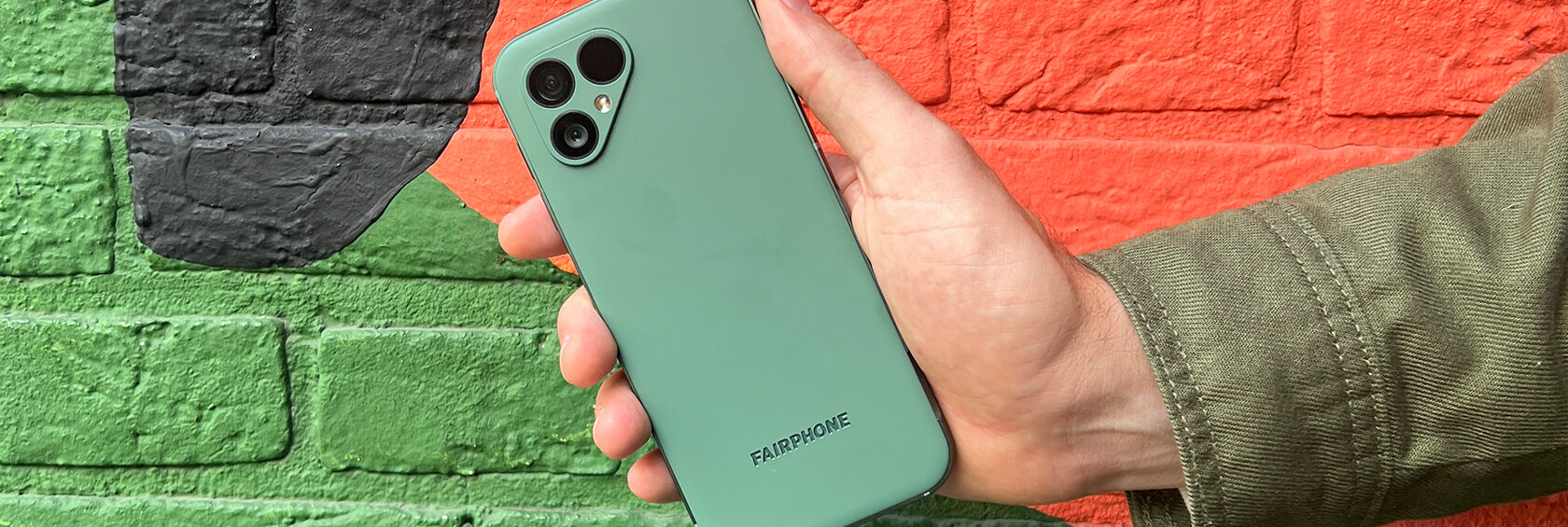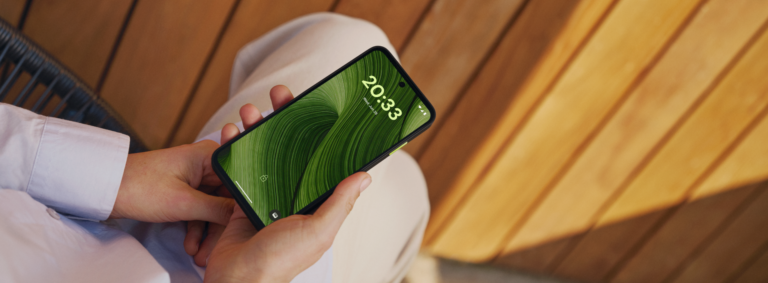How to design a Fairphone 101
“Sustainable smartphone? How can a smartphone be sustainable?”
Whenever we tell people about Fairphone, this is usually the standard response. And to be fair (pun intended), it is a valid question. Put bluntly, a smartphone that is 100% sustainable is not realistic, at least not right now. However, that doesn’t mean that smartphones (and by extension, audio products) can not be more sustainable. At Fairphone, we are setting an example for the industry by designing all our products to be physical proof of just that. More sustainable than the competition, more sustainable with each generation. We achieve this by pushing for modular design that is easy to repair, by offering industry-leading warranties and support periods, by incorporating fair and recycled materials in the supply chain, by championing fairer working conditions across mines and factories, by supporting living wage bonuses, and by pushing for 100% e-waste neutrality… among other things. It’s not just talk. We have the data to back us up. And after more than a decade of doing what we do, we’re starting to see tangible change within the tech industry, with more and more brands now mulling longer software support periods for their devices and exploring fairer materials as well. But we’re jumping ahead. We put together this article to help you trace the journey of making a Fairphone from scratch, from an idea to a finished product. Let’s get into it.
The Product Proposition: How can we help you (and the planet)?
So, how do we even begin creating a Fairphone? Well, it all starts with you! Over the last decade (and counting), we have spent a lot of time really getting to know members of the Fairphone community like yourself—what makes you tick, what frustrates you with other phones, the concerns and anxieties people might have about switching to a newer brand like us. Jan Sander, Fairphone’s Product Marketing Lead, sums it up well, “Research is key. Over the years, what we realized is that impact features might drive brand interest, but not necessarily immediate purchase decisions.” This really shines through when you trace the evolution of Fairphones over the years. The Fairphone 2 was the first one we designed from scratch to be modular. And while having each component encased in its own housing was cool, we realized that a better camera and a more compact form factor was something our community valued more. So, with the Fairphone 4 and 5, we really pushed the boundaries of what’s possible spec-wise, while still designing them to be really easy to repair.
“Nowadays, we have a much clearer idea of our community and what they need. So when designing a new product, we are able to draw up a much better product proposition. This dictates what features we want to focus on, and what we leave out.” When we asked him for examples, Jan pointed to the Fairphone 5. “For instance, when we were thinking about the Fairphone 5, we heard loud and clear that the Fairphone 4 was still a bit bulky and the camera still needed to be better. That feedback directly shaped what the Fairphone 5 looked like.”
This task becomes even more complicated, when you keep in mind that, at Fairphone, we’re not churning out multiple models every year. That means our internal teams have to make choices that will hold up years down the line, from the processor and camera to the display and battery. What really makes Fairphone, Fairphone, is how sustainability is baked into everything from day one. When we’re putting together our product requirements and figuring out partners and suppliers, we don’t just ask about tech specs; we’re always considering impact specs too!
Let’s Talk Impact: Putting the ‘fair’ in Fairphone
Making a smartphone is a huge team effort involving engineering, product, supply chain, software and quality assurance, among others. Making a sustainable smartphone needs one more dedicated set of players, and that’s Fairphone’s incredible impact team. It’s their job to make sure we don’t settle for just any supplier, but instead, to find partners who are on board with our vision for fair materials and ethical factory operations.
According to Angela Jorns, Head of Impact Innovation, “Everything we do is a push for what seems impossible.” This goes back to what we said at the start of this blog—a 100% fair phone just doesn’t exist yet. So, every decision, from battery size to material choice, is a balancing act between what you want as a customer, the price, quality, and Fairphone’s impact goals. But Angela sees this as a welcome challenge. “These « constraints » actually force us to innovate in ways other companies don’t. It’s the most exciting part of the job, pushing us to find creative solutions in the electronics world.” As a result, we’re super proactive about integrating recycled materials and sourcing from fair mines – like those assessed by the Initiative for Responsible Mining Assurance (IRMA). We also work with suppliers and factories to track progress through remote follow-ups and repeat visits. If a partner isn’t quite there yet but shows a willingness to improve, we’re all ears.
It’s something that Angela really values about Fairphone. “We’re the only organization that I know of where our annual impact targets are just as important as our annual sales targets. We need to achieve both, company-wide. This goes a long way in influencing decision-making, and providing a strong argument for the impact team in trade-offs.” With both impact and marketing working together, there are always discussions about what makes for good marketing, and what might come across as greenwashing. As per Jan, “There are brands out there that claim to be carbon-neutral, for example, which can help create a lot of buzz from a marketing and PR perspective.” But at Fairphone, this is something we actively avoid. According to Angela, “Claiming carbon neutrality through offsetting isn’t the full answer. We’re all about genuinely reducing our footprint, aligning with scientific targets and best practices. It’s about making a real impact.”
The Design Stage: Making Smart Choices (and Smart Trade-offs)
Once we’ve got a good handle on the concept and feasibility of our new product, it’s time to start translating this into the real world. It is at this stage that we bring in external design agencies to help us. With the Fairphone 5, we had locked Swedish design agency, Above, for this part. For our audio products, we work with Belgium-based Dott Achilles. From this point onwards, a back-and-forth begins with the design agency and our manufacturers, sharing requirements and refining plans.
Having a concept in place and a wish-list of requirements doesn’t mean everything makes it to the final product. There’s a lot of push and pull in different directions. This brings us back to the dance between user needs, impact requirements, and overall costs. Fairphone Product Manager, Javier Manrique, puts it perfectly, “It’s all about balance. Do we want a bigger battery or smaller display? How do we offer the best cameras possible without breaking the bank for the end-user? There are a variety of factors to consider, and some hard decisions to make.” The mini-jack on the Fairphone 3 is the perfect example. Like we mentioned earlier, user feedback showed us that bulkiness was a bigger concern for the majority of our users, so we had to remove the headphone jack to make the Fairphone 4 thinner.
Having said that, we’re still not making enough hard decisions, according to Fairphone co-founder, Miquel Ballester. “The Fairphone 5 is a good example of where we tried to do much, without excelling in one area. Learning from that, we’re making more focused choices for our future designs.”
Post The Launch: Always learning, always improving.
Our journey doesn’t end when a phone launches. We’re constantly learning and improving our products, even after they release. With the Fairphone 3, we figured out hardware upgrades to make the camera better, resulting in the Fairphone 3+. But when we decided to revisit the shooting experience on the Fairphone 4, we realized it was more cost-effective and practical to upgrade the software instead. “The hardware on the Fairphone 4 was already really, really, good. So swapping the hardware out would not have made a massive difference. The software was what would benefit the most from fine-tuning. And when the update was ready, we made it free. This meant every Fairphone 4 user could benefit from the improved shooting experience, without having to spend more money for it,” says Javier. This approach is a crucial pillar for our long-lasting promise. Our devices need to be future-proof to be able to serve their purpose effectively for their owners years down the line. And with constant innovation, this is something we are able to address effectively.
So there you have it. We’re hoping you have now understood the thought process that goes into designing a sustainable smartphone. Stay tuned for more insights into how we raise the bar for sustainable electronics across the industry.



